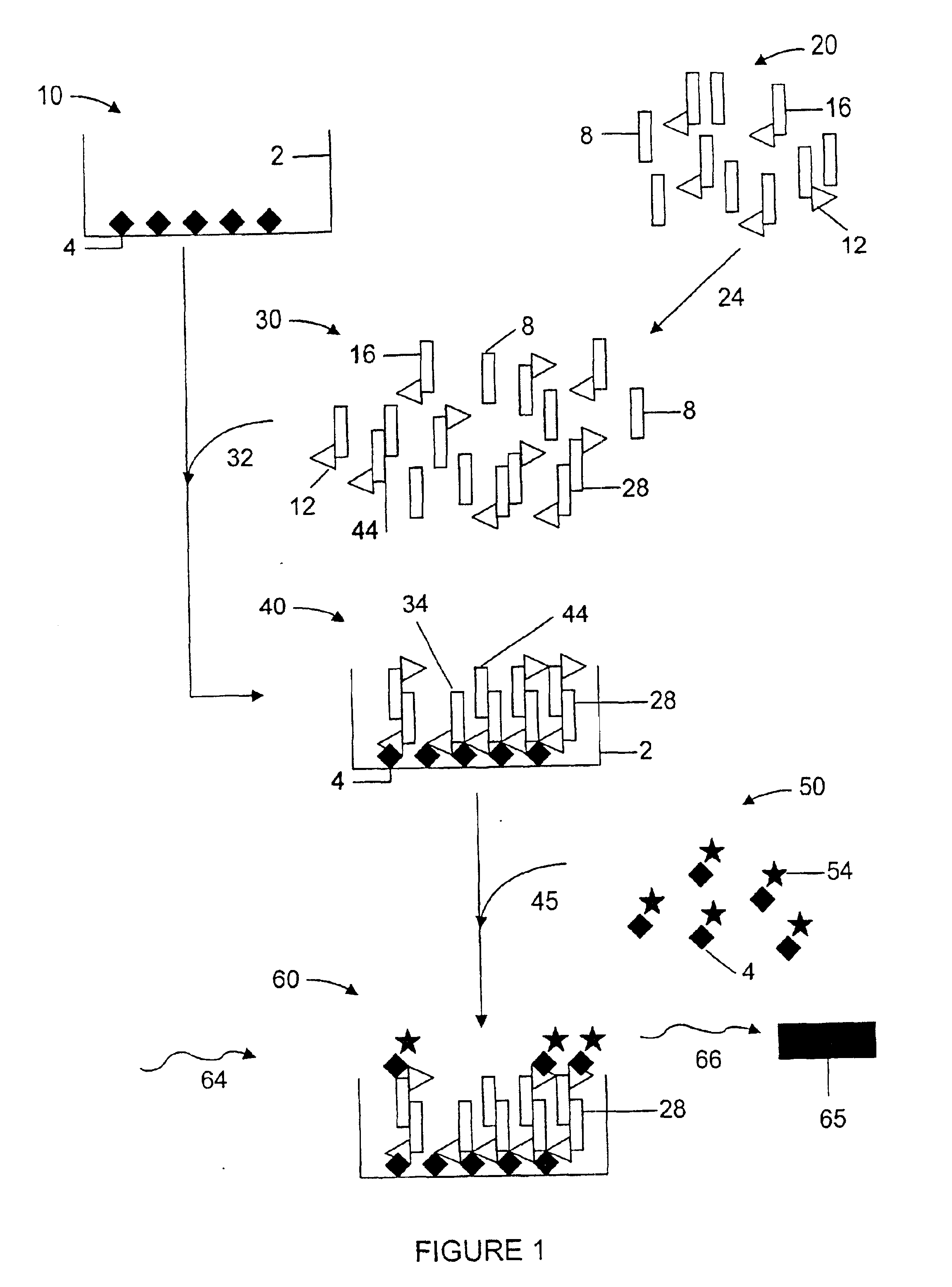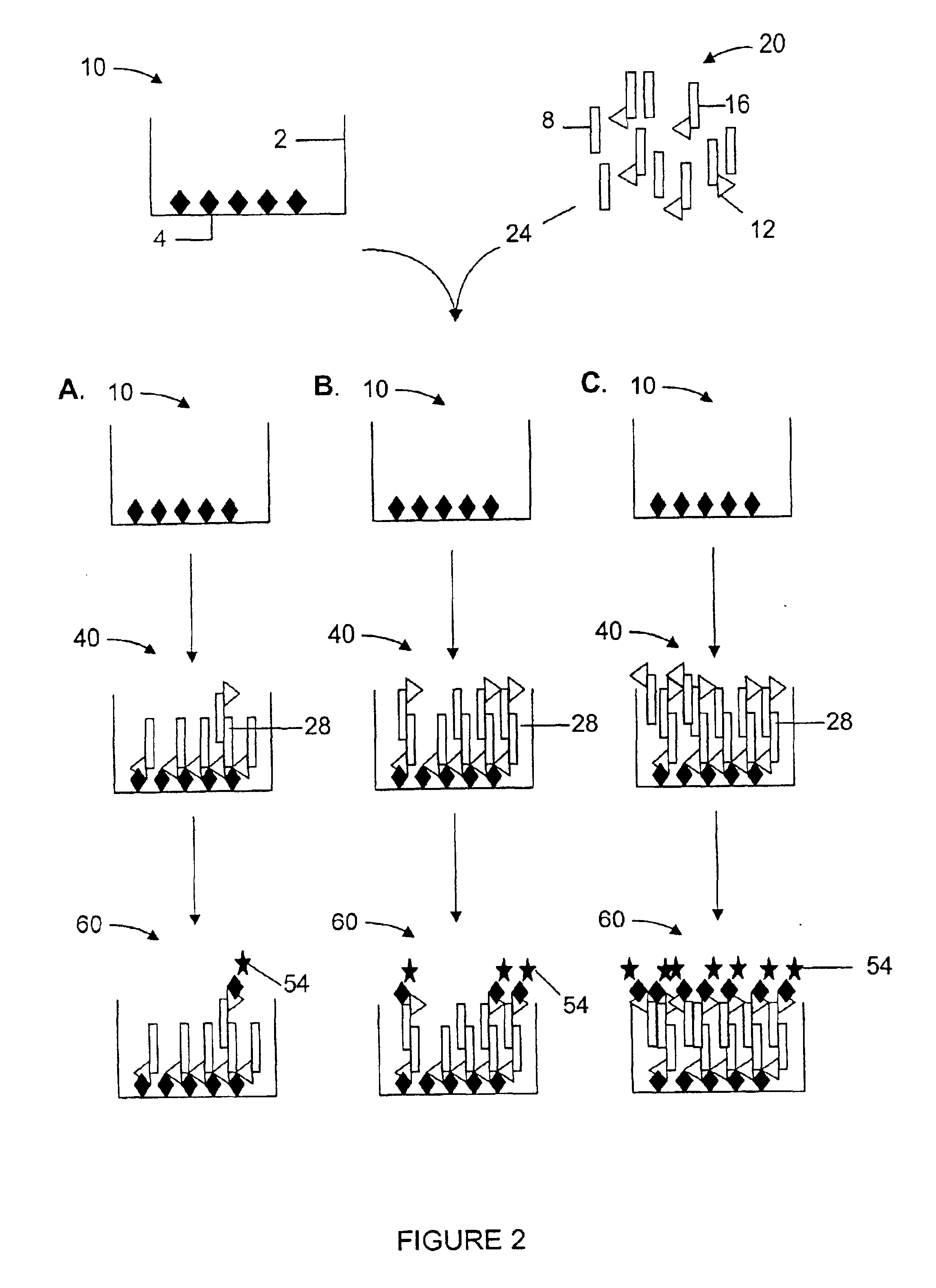Time-resolved fluorescence assay for the detection of multimeric forms of A-beta 1-40
a fluorescence assay and multimeric technology, applied in the field of methods, can solve the problems of complex method of detecting peptide complexes, abnormal physiological functions at the plaque site, toxicity and death of neuronal cells, etc., and achieve the effects of reducing the amount of reagents required, reducing the cost of the assay per sample, and reducing the cost of the assay
- Summary
- Abstract
- Description
- Claims
- Application Information
AI Technical Summary
Benefits of technology
Problems solved by technology
Method used
Image
Examples
example 1
Time Resolved Fluorescence Assay For β-Amyloid Polypeptide Aggregation
The following example is an embodiment of the invention which demonstrates a method for identifying modulators of β-amyloid polypeptide aggregation. β-amyloid polypeptide monomers in solution in vitro are pre-disposed toward aggregation of the peptide monomers into larger, multimeric molecules. Aggregation of the β-amyloid monomers in vivo is a primary contributor to neuronal damage in Alzheimer's Disease. The present invention allows for a sensitive in vitro analysis of β-amyloid aggregation and the effects of outside compounds or test agents on the extent of β-amyloid peptide aggregate formation.
Beta-amyloid 1-40 (Aβ) and biotin-labeled β-amyloid 1-40 peptides were purchased from Biosource (Camarillo, Calif.). β-amyloid and biotinylated amyloid stock solutions, diluted in 0.1% acetic acid and corrected for 80% peptide content, were diluted to 83 μg / ml and 42 μg / ml, respectively, in reaction buffer (Dulbecco's PB...
example 2
Comparison of TRF Assay to Standard ELISA Potocol
For the β-amyloid aggregation ELISA protocol (Howlett et al., supra), 96 uL diluted β amyloid solution (51 μg / ml) is added to a 96-well polystyrene plate in the presence of and absence of 2 μL of an aggregation inhibitor test compound diluted in DMSO. The Aβ is incubated overnight to allow for aggregation and an aliquot transferred to another 96-well polystyrene plate, precoated with anti-Aβ antibody (6E10, Senetek, Napa, Calif.) overnight, washed, and blocked with Dulbecco's PBS / 1% BSA solution. After 3-4 hours, the plates were washed and a secondary anti-Aβ antibody demonstrating the same specificity as the coating antibody but biotinylated (6E10-bio) was added to the plate. The secondary, biotinylated antibody was bound with 200 μL Eu3+-streptavidin (100 ng / ml) in DELFIA assay buffer, the excess washed off, and the plate developed in DELFIA enhancement solution and read on a TRF plate reader as outlined above.
Analysis of the absorb...
example 3
Improved Rate of Detection of Modulators of β-amyloid Nucleation and Aggregation
Coupling of the TRF-Assay described above with a turbidity, or optical density, assay can vastly improve the ability to detect modulators of β-amyloid nucleation and aggregation. A turbidity assay measures the onset of aggregation, or nucleation, of aggregating proteins. A nucleation event is characterized by a considerable lag time in the appearance of aggregates precipitating out of assay solution and giving off an optical density (OD) reading, followed by a rapid increase in OD due to acceleration of aggregation.
A test compound that has been determined to modulate β-amyloid aggregation in the TRF assay can also be assayed in an optical density assay (Findeis et al, Biochemistry 38: 6791-6800. 1999; and WO98 / 08868) to verify if the compound is involved with nucleation of β-amyloid aggregates, or if the compound only inhibits β-amyloid aggregation after the initial seeding of aggregates has occurred.
For...
PUM
| Property | Measurement | Unit |
|---|---|---|
| Aggregation | aaaaa | aaaaa |
Abstract
Description
Claims
Application Information
 Login to View More
Login to View More - R&D
- Intellectual Property
- Life Sciences
- Materials
- Tech Scout
- Unparalleled Data Quality
- Higher Quality Content
- 60% Fewer Hallucinations
Browse by: Latest US Patents, China's latest patents, Technical Efficacy Thesaurus, Application Domain, Technology Topic, Popular Technical Reports.
© 2025 PatSnap. All rights reserved.Legal|Privacy policy|Modern Slavery Act Transparency Statement|Sitemap|About US| Contact US: help@patsnap.com


